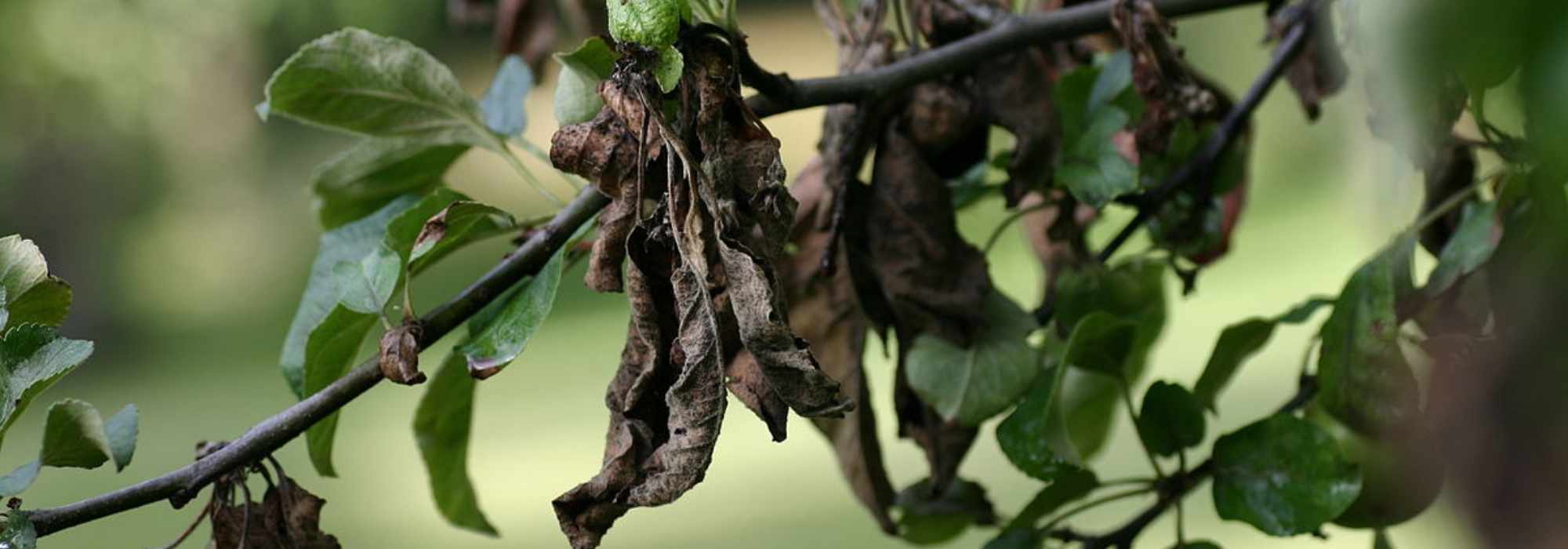
Fire blight: identifying and combating this disease
against this disease
Contents
Fire blight is a very serious disease, caused by the bacterium Erwinia amylovora, which can kill a vigorous tree within 3 months. It exclusively attacks plants in the Rosaceae family and has wreaked havoc in pear orchards and on hawthorns in the past.
The potential appearance of this disease, also known as “fire disease,” is closely monitored in professional orchards but can be transmitted from private gardens through ornamental plants such as Cotoneaster, Pyracantha, and hawthorn, which are the most susceptible.
The bacterium Erwinia amylovora, responsible for fire blight, is subject to obligatory control in nurseries (European Directive 2000/29 EC) as well as in all other locations such as orchards, green spaces, hedges, and private gardens (Order of 31 July 2000). It must lead to sanitation, or even uprooting.
The disease is recognised by the burnt appearance that branches take on one after the other. There is no treatment other than preventive measures such as controlling aphids, limiting injuries and splashes, etc. Uprooting and burning must be carried out as soon as possible (obligatorily before the end of October) to limit contagion.
Which species are sensitive to Fire blight?
Les Cotoneaster, Pear tree (Pyrus), Pyracantha, Hawthorn (Crataegus) are classified among the most sensitive hosts, and a law prohibits the propagation, distribution, and planting of certain species and cultivars known to be very sensitive, such as the Passe-Crassane pear, Cotoneaster bullatus, salicifolius, watererii, congestus and their cultivars, Pyracantha atalentoïdes ‘Gibsii’, ‘Berlioz’, ‘Debussy’ and Pyracantha angustifolia… Nurserymen, in turn, promote the distribution of resistant cultivars such as Pyracantha Cadrou Saphyr Rouge or Cadrange Saphyr Orange and other less sensitive species.
Be aware that other plants can harbour and transmit the bacterium without drawing attention, such as Amelanchier, Aronia, Japanese Quince (Chaenomeles), Quince (Cydonia), Japanese Medlar (Eriobotrya), apple (Malus), medlar (Mespilus), Photinia, Raphiolepis, Sorbus…
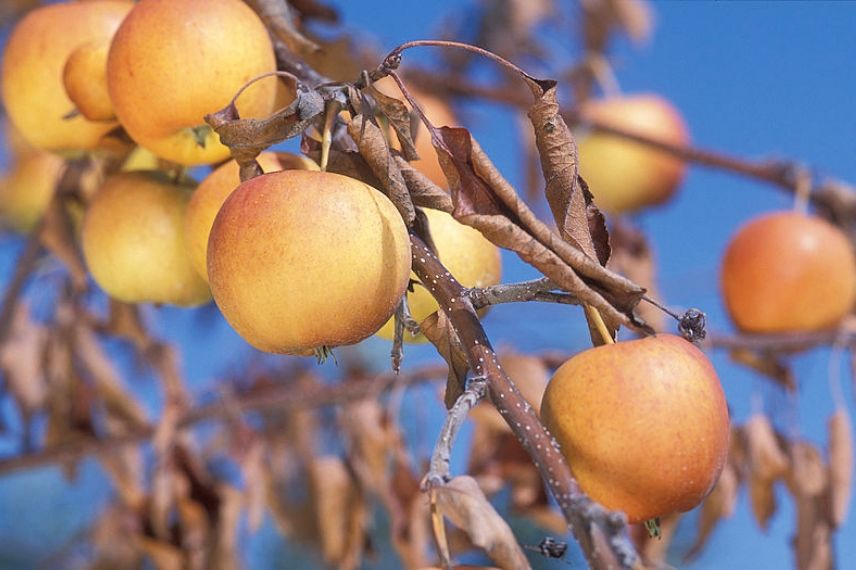
Severe bacterial fire infection on a Gala apple tree
Read also
Brown rot of fruit treesHow to recognise Bacterial Blight?
- The first symptoms appear in spring on flowers that wilt and dry out.
- Necrosis spreads to the bearing branches whose tips curl into a crozier and dry out. Young shoots turn brown (in apple trees) or black (in pear trees) suddenly as if they were burned but often remain attached to the branches.
- A whitish – golden flow in apple trees – is observed on infected organs (bark, fruits, shoots…) in mild and humid conditions.
To be sure it is bacterial fire, we advise you to:
- cut a diseased branch and observe the cross-section: the tree ring just beneath the bark is brown-red and appears wet and shiny. The transition between the healthy and infected parts is gradual, and droplets from the bacteria (exudates) sometimes ooze out. Laboratory analysis can confirm the disease.
The progression of the disease:
- The disease spreads to the branches, the main branches, and even the trunk, causing cankers. These lead to the sudden death of branches or the entire tree by cutting off the circulation of sap. The canker, varying in size, has a slightly sunken surface surrounded by cracked bark, with inside, reddish-brown or brown areas that extend towards healthy tissues. They often appear waterlogged. They harbour the bacterium during winter, which spreads to other plants through the whitish exudates that form at the margin of the cankers in spring or later on newly contaminated shoots and fruits.
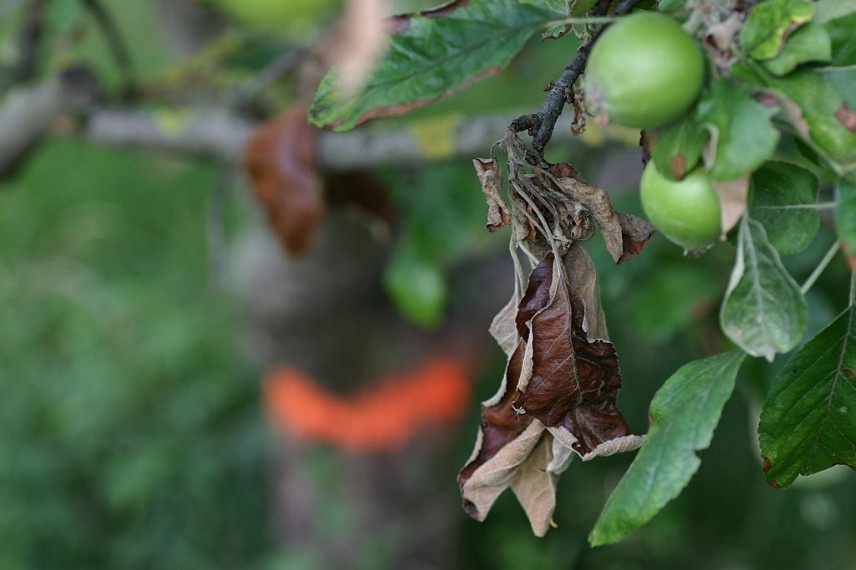
Discover other Pear trees
View all →Available in 1 sizes
Available in 1 sizes
Available in 1 sizes
Available in 1 sizes
Available in 1 sizes
Available in 0 sizes
Available in 0 sizes
Available in 1 sizes
Available in 0 sizes
Factors Favouring Bacterial Fire
A warm (between 12 and 24°C) and humid period encourages the development of the bacterium which enters through natural openings such as the nectaries of flowers or the stomata (pores located beneath the lamina), through injuries caused by thin, wind, or even by pruning.
It is during the flowering and peak growth periods that the plant is most receptive, but symptoms are generally observed just after flowering, on the young fruits that dry out.
Control and Treatment of Bacterial Fire
There is no true curative treatment even though copper can limit new infections.
Control relies on precautions and preventive methods, particularly early detection of symptoms and regular removal of infected shoots.
How to prune infected shoots?
A recently infected shoot presents 3 areas that are important to visualise:
-
- the blackened or scorched “burnt” tip,
- an intermediate area where, when you lift the bark, the tissues are often reddish,
- and a healthy-looking area that nonetheless harbours the bacterium.
Prune the infected shoots, at least 30 cm below the intermediate area for apple trees and up to 1 m below this area for very sensitive pear varieties like Passe-Crassane. Proceed as quickly as possible but in dry weather.
In the case of a severe attack, when the intermediate area is close to the trunk, removal of the infected tree is obligatory and must be carried out, according to the law, by the end of October of the current year.
The progression of the disease within the tree is all the faster when growth is vigorous.
Precautions to take during pruning
- Disinfect the cutting tool between each shoot pruning by soaking it in 70° alcohol (more effective than burning alcohol at 90°) or in white vinegar by diluting 50 ml in 1 l of water.
- Dispose of pruning waste in dry weather (you can leave it in place for 24 hours in dry conditions to attenuate the bacterium’s activity) and then burn it. Avoid back-and-forth movements on an infected plot. Return a few days after the first pruning and then once a week to remove any new infected shoots.
- Avoid watering infected plots by spraying and at ground level and stop any new nitrogen input which stimulates growth and thus increases the tree’s sensitivity to the bacterium.
- If a second flowering appears on the infected tree, remove the flowers and monitor the new summer shoots.
- Check nearby hedges that may harbour species sensitive to the bacterium such as Hawthorn, Pyracantha, certain Cotoneasters, Quince, Medlar, Sorbus, etc. A distance of 500 m is recommended between these species and the orchard.
- After leaf fall, remove any shoots bearing cankers or dry leaves from the tree.
- If you practice grafting, be cautious with apple and pear grafts that can transmit fire blight (current apple rootstocks are resistant to the disease).
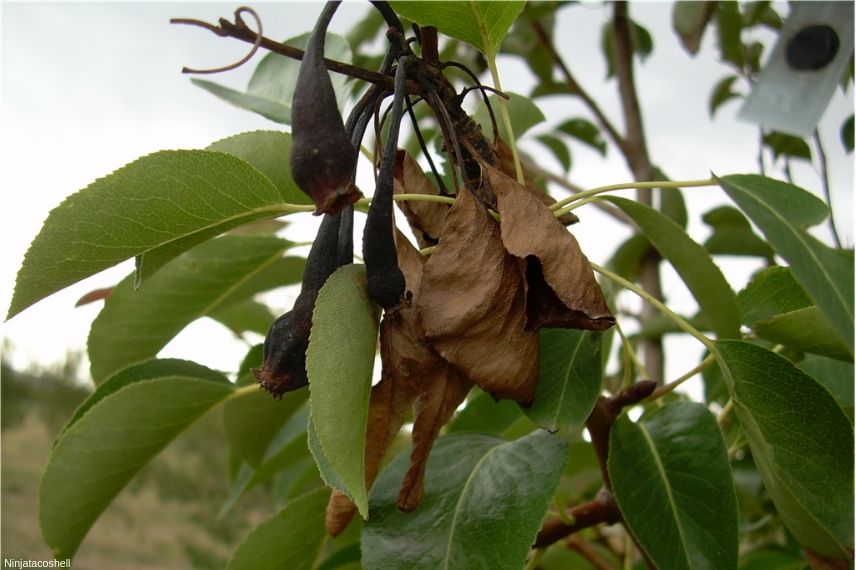 Fire blight on a pear tree
Fire blight on a pear tree
The risks of confusion
- The bacterium Pseudomonas syringae on pear (bacterium): flowers and small dry black fruits fall shortly after flowering but no exudate is visible and brown-black spots appear on the leaves in summer, more extensively than with Bacterial Blight within the tree.
- Leaf Scorch on pear, particularly in the variety Conference: the foliage darkens due to water stress, but the central vein of the leaves remains green.
- The Vine-plant is a common insect on pear, but can also be found on apple, quince, and hawthorn, causing darkening and curling of shoot tips up to 15 cm maximum, with characteristic spiral punctures at the base.
- Moniliosis causes floral bouquets to wilt within a few days, becoming brittle and falling but showing no exudate. A cross-section of the branch shows a clear demarcation to the healthy bark.
The legislation surrounding fire blight
- In France, the planting of particularly sensitive varieties, such as the Passe-Crassane pear, is prohibited, while the multiplication and planting of species sensitive to bacterial fire is subject to authorisation from the government.
- For your information, you will find here the list of plants whose planting and multiplication are prohibited on national territory due to the risks associated with bacterial fire.
- At the departmental level, municipalities corresponding to buffer zones have been defined by prefectural order and are subject to systematic checks on species sensitive to bacterial fire. In the event of confirmed contamination, you must inform your town hall or the Regional Plant Protection Service so that they can take the necessary measures to prevent contagion. It should be noted that if the uprooting of the tree is recommended, it must be done before the end of October of the current year.
- Subscribe!
- Contents
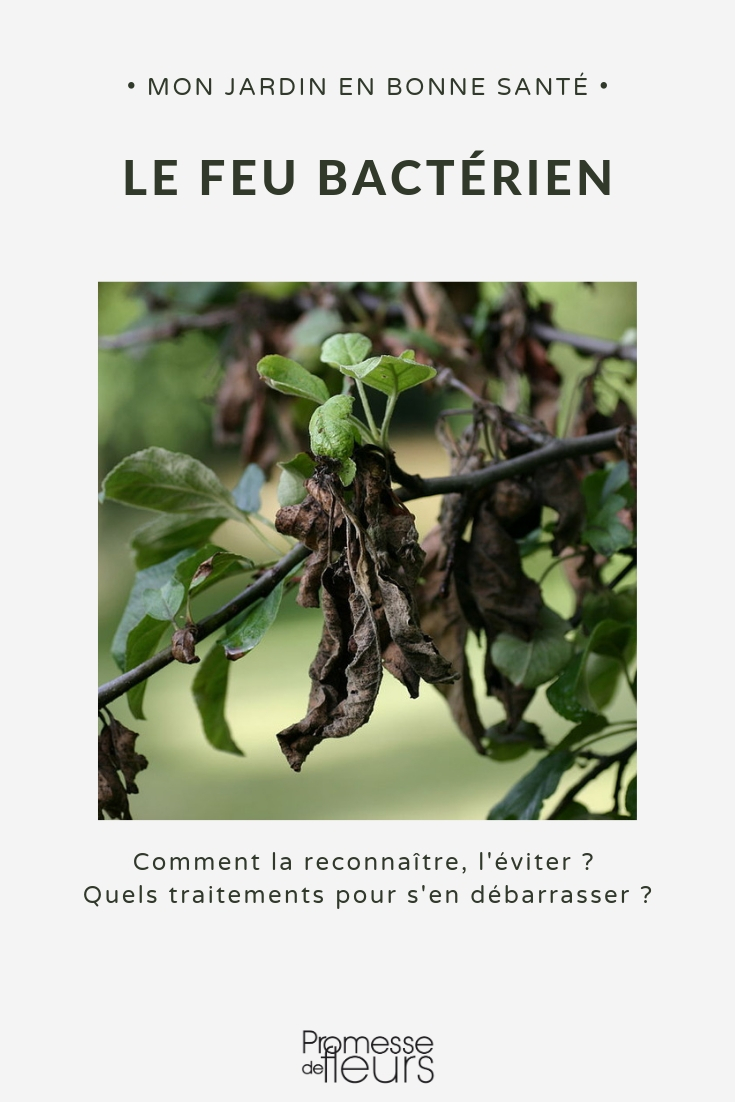
































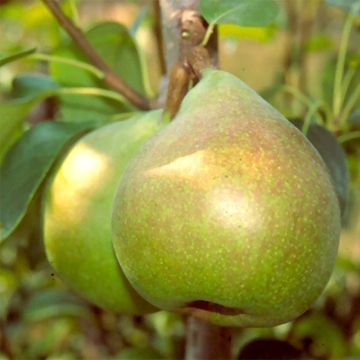
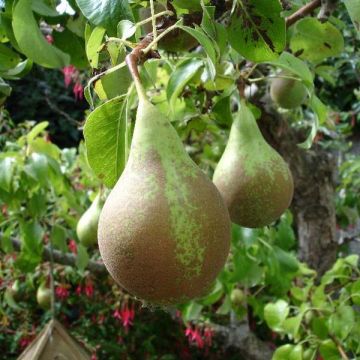
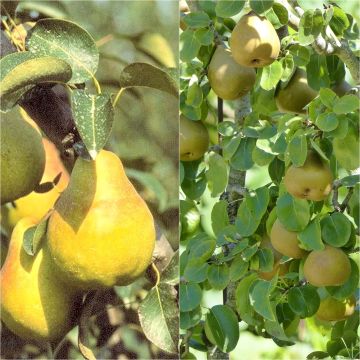
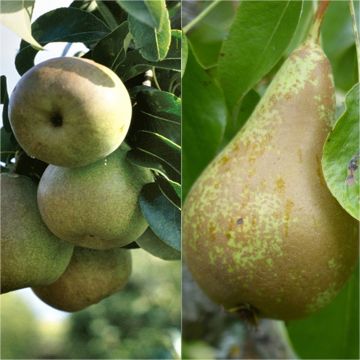
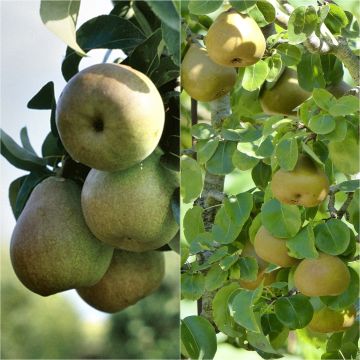
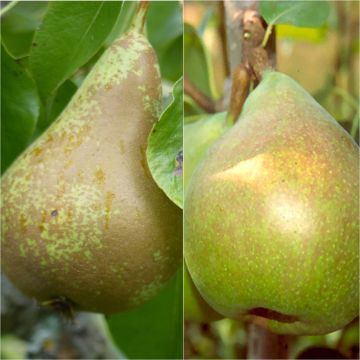
Comments